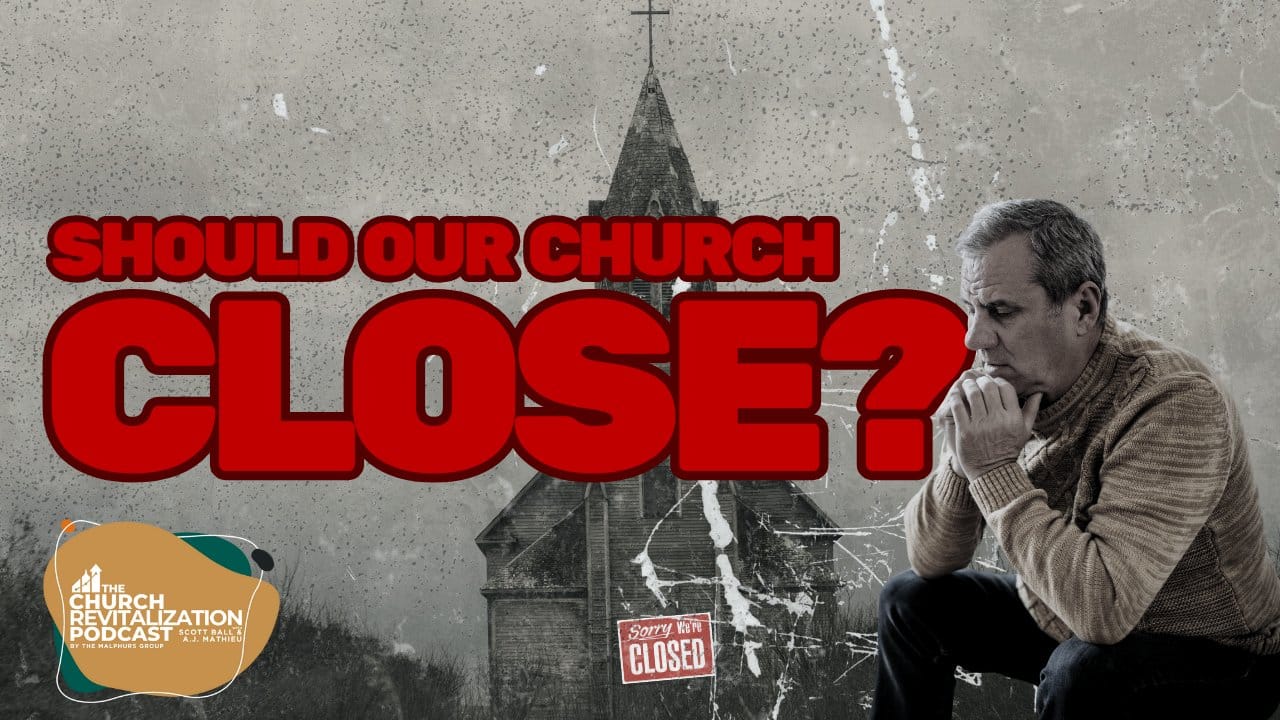The Church Revitalization Podcast – Episode 309– church closure decision
The church closure decision is one of the most heartbreaking conversations a pastor or church leader will ever face. Yet for many congregations across America, this discussion has moved from unthinkable to unavoidable. Recent studies show that 4,500 churches closed in 2019 while only 3,000 new congregations started, and researchers project that 100,000 North American churches could close by 2050.
But here’s what many church leaders don’t realize: the church closure decision isn’t simply about whether your doors will stay open. It’s about discerning God’s next step for your congregation—whether that’s revitalization that breathes new life into your ministry or faithful closure that seeds new Kingdom work.
The question isn’t whether struggling churches exist—they do, in significant numbers. The question is how to make a wise church closure decision that honors both your congregation’s legacy and God’s ongoing mission in your community.
When Is Your Church Beyond Revitalization?
Not every struggling church faces an inevitable church closure decision. Size alone doesn’t determine a church’s viability—some congregations of 30 people have experienced remarkable turnarounds. The key factor isn’t just numbers; it’s what we call critical mass.
Critical mass refers to having enough engaged, energized people willing to invest in the hard work of revitalization. When making a decision, this becomes challenging when a church drops below 30 people and the vast majority of those remaining are either apathetic or simply lack the energy to focus on renewal.
Consider two churches facing the same question, each with fewer than 40 members. Church A has 35 people in their 80s who love their church but are physically and emotionally exhausted from years of decline. Church B has 30 people in their 40s-60s who are heartbroken about their church’s condition but ready to roll up their sleeves and try something new. The one that should pursue revitalization is Church B; Church A likely faces a church closure decision.
Money complicates the decision but doesn’t determine it. Plenty of churches have died with money in the bank, while others have experienced renewal despite financial struggles. Money can help revitalization efforts, but it cannot buy church health, enthusiasm, or the willingness to change. In fact, financial stability sometimes masks deeper symptoms of decline, allowing churches to delay facing closure until it’s too late.
Church Revitalization as CPR: When There’s Still Hope
For churches hovering near that critical threshold, revitalization becomes like CPR for a person without a pulse. This analogy helps clarify when a church closure decision might be premature:
Church revitalization can and does save congregations—but not every time. No paramedic thinks, “Well, CPR might not work, so we shouldn’t try it.” They think, “This sometimes works, so let’s give it everything we’ve got.” The same mindset should apply when facing the closure question.
Effective church revitalization can break some “ribs” in the process—but when the alternative is closing, the relational costs become worthwhile. Church revitalization often requires touching “untouchable” traditions, restructuring leadership, and making changes that feel uncomfortable or even painful. But if the alternative is shutting the church down, those uncomfortable changes become worthwhile investments.
There’s no harm in attempting church revitalization when the alternative is the death of the church. If you attempt revitalization and it doesn’t work, you’re no worse off than if you had moved directly to the closure. But there’s always the chance it could work.
Church revitalization requires proper technique and outside help—you cannot perform CPR on yourself. Similarly, churches facing a potential church closure decision cannot revitalize themselves. This isn’t a reflection of incompetence; it’s simply the nature of the situation. If internal leadership could have turned things around, they likely would have by now.
For churches in this critical state, professional guidance becomes essential before making a church closure decision. Whether through a strategic planning process like Strategic Envisioning from The Malphurs Group or other proven methodologies, outside help provides the expertise and objectivity that internal leadership cannot supply.
The honest truth about the church closure decision? We’ve had conversations with church leaders where we’ve said, “We don’t see your church surviving more than a couple of years on your current trajectory. We cannot promise this process will work, but it’s certainly worth a shot because the cost is affordable.” Sometimes church revitalization works; sometimes it leads to a church closure decision. But it’s always worth attempting when the alternative is certain closure, and the people are willing to put in the work.
When Church Closure Decision Becomes Kingdom Investment
For some congregations, the most faithful decision is to close well. This isn’t failure—it’s stewardship. Just as organ donation can give life to others after physical death, a church’s assets can seed new Kingdom work through an intentional church closure decision.
Option 1: Become a Satellite Campus
Partner with a healthy, growing church that can adopt your congregation through your church closure decision, providing new leadership and breathing fresh life into your ministry. This model is becoming increasingly popular among mid-size churches (100-1,000 members) that want to serve struggling congregations in their area. The adopting church provides pastoral leadership and resources while honoring the history and relationships of the original congregation.
Option 2: Invite a Church Planter
Rather than trying to revive your existing structure, your decision can involve donating your building and resources to a vetted church planter who can start fresh with new leadership, new vision, and new organizational DNA. This isn’t your church continuing under new management—it’s a completely new church being born from your generous choice.
Option 3: Sell or Donate Assets Strategically
If your building needs significant repairs or isn’t suitable for ongoing ministry, your church closure decision might involve selling it and donating the proceeds to church planting organizations, denominational church planting funds, or ministries focused on church revitalization. One well-planned church closure decision could potentially fund the revitalization of dozens of struggling congregations.
The key principle in any church closure decision: Give your first fruits, not your leftovers. Don’t be the church with 13 people that insists on keeping the prime Sunday morning slot while offering the church planter a 1 p.m. time slot. If your church closure decision involves blessing another ministry, bless them with the best of what you have to offer.
Theological Foundation for Church Closure Decisions
Perhaps the most important truth for churches wrestling with a church closure decision is this: God’s mission continues whether or not your specific congregation does.
In Revelation 2:5, Jesus warns the church in Ephesus: “If you do not repent, I will come to you and remove your lampstand from its place.” This sobering reminder tells us that Christ sometimes does make the church closure decision for congregations. But notice—while He may remove lampstands, He himself remains the flame. His work doesn’t depend on any single congregation’s survival.
From an eternal perspective, a church building that looks renewed is a powerful witness to resurrection—regardless of whether that renewal comes through successful revitalization or through a new church plant using your facility after a church closure decision. Passersby see something powerful: a place that looked near death now shows signs of life. This visual testimony can draw curious visitors who might never have considered investigating your ministry otherwise.
The work of the Kingdom is bigger than any one local church. Your congregation may have served faithfully for decades, loved your community well, and made disciples who are now serving Christ around the world. That legacy doesn’t disappear because of a church closure decision. The ripple effects of your ministry will continue until Christ returns.
This doesn’t minimize the grief of a church closure decision. Losing a church family is genuinely heartbreaking, and that pain deserves to be honored. But it also shouldn’t be the end of the story for the people involved. Many former members of churches that made closure decisions find new life and purpose in other congregations, sometimes bringing wisdom and perspective that proves invaluable to their new church families.
Making Your Church Closure Decision: Practical Next Steps
Whether your church ultimately chooses revitalization or makes a church closure decision, the choice should be made with prayer, wisdom, and an eternal perspective. Here are some practical steps for navigating your church closure decision:
If You’re Considering Revitalization
Don’t attempt it alone. Your church closure decision shouldn’t be made in isolation. Seek outside help from proven consultants or denominational leaders before concluding that closure is inevitable. Be honest about your chances, but remember that what looks impossible to you may not be impossible to God. The investment in professional guidance is minimal compared to the potential blessing of avoiding a premature church closure decision.
Assess your critical mass honestly. Do you have enough engaged people to make revitalization possible? Are they willing to embrace significant change? If the answer is yes, your church closure decision should be postponed in favor of attempting revitalization.
If Church Closure Decision Seems Inevitable
Begin planning now. Don’t wait until you can no longer pay the bills or maintain the building to make your church closure decision. Proactive closure allows you to be intentional about stewardship and Kingdom impact. Consider which of the closure options above might best serve God’s purposes in your community.
Create a closure committee. Don’t let one person carry the weight of a church closure decision alone. Form a team to handle the practical and emotional aspects of closing well, including legacy planning and asset distribution.
In Either Case
Remember that God’s love for your community doesn’t depend on your church’s survival. Whether you choose revitalization or make a church closure decision, He will continue to work in your area. Your calling is to be faithful with what He’s entrusted to you, whether that leads to renewal or to a different kind of Kingdom investment.
The church closure decision is ultimately a question of stewardship. How can we best use the resources God has given us—people, property, and finances—to advance His Kingdom? Sometimes the answer is revitalization that brings new life to existing congregations. Sometimes it’s a church closure decision that seeds new ministry and demonstrates faithful stewardship of God’s gifts.
But in every case, the church closure decision involves surrender, hope, and trust in the One who holds the future of His church in His hands. Whether your story continues in the same building with renewed life or concludes with a legacy that launches new ministry, God can use your faithfulness to advance His Kingdom in ways you may never fully see this side of heaven.
Also check out:
The Need for Church Planting and Revitalization
How to Know if You’re Ready to Lead a Revitalization Process
Watch this episode on YouTube!


A.J. Mathieu is the President of the Malphurs Group. He is passionate about helping churches thrive and travels internationally to teach and train pastors to lead healthy disciple-making churches. A.J. lives in the Ft. Worth, Texas area, enjoys the outdoors, and loves spending time with his wife and two sons. Click here to email A.J.

